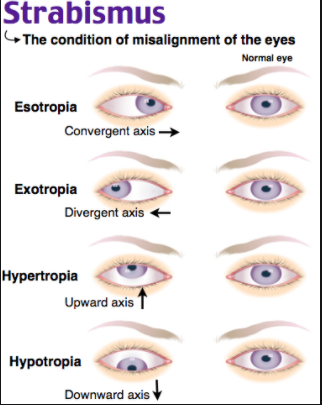
What is Strabismus?
It's a visual disorder in which both eyes don't look at the same point in the same time. Strabismus usually starts in childhood; however, any kind of asymmetric direction of the eyes in any generation is considered strabismus.
There are many causes of Strabismus, e.g. hyperopia or cataract. Strabismus leads to difficulty of vision due to asymmetric eye movement. There are many options to treat Strabismus, as wearing glasses or treatment of the cause or surgical operations. Strabismus could be very severe and stressful and results in psychological troubles to the children and affects child's cosmetic appearance and his ability to see as well as social difficulties he may experience. So we recommend treating strabismus as soon as possible.
Types of strabismus:
There are many types of strabismus, according to direction of the eyes:
- Esotropia: the affected eye is directed toward the nose.
- Exotropia: the affected eye is directed to the outside.
- Hypertropia: the affected eye is directed above.
- Hypotropia: the affected eye is directed below.
Symptoms of strabismus:
Signs and symptoms of strabismus are related to age of the patient, since strabismus is more common in children, it's important to observe and detect it early. Most common symptoms are:
- Eyes don't look in the same direction.
- Eyes don't move symmetrically.
- Closing one eye on exposure to bright light.
- Bending the head when looking at certain object.
- Hitting the objects.
If strabismus appears in older children, new symptoms may appear such as double vision, eye strain, photosensitivity or blurry vision. Symptoms may appear frequently and infrequently, and increased by fatigue or acute distress. If you notice asymmetry in your child's eye, seek ophthalmologist advice immediately, especially if present in the first four months of life.
Treatment of strabismus:
There are many guidelines to treat strabismus, some of which aim to treat the cause such as cataract by surgical treatment or treat hyperopia by glasses. Another aim to treat strabismus is to avoid amblyopia.
Glasses: Glasses aim to treat hyperopia that cause strabismus. Wearing glasses can also treat mild strabismus.
Eye patch: strabismus can lead to amblyopia, so closing the normal eye by temporary patch is important to increase the strength and movement abilities of the affected eye, so it can restore its normal position. The duration of eye patch may vary according to the case, and it ranges from weeks – months.
Surgical treatment: it's the last option to treat strabismus, and most cases require surgery. These types of surgeries are done at hospital under general anesthesia and last for a short period, after which the child returns to his daily life activities. The surgeries aim to straighten the eye by partial amputation of eye muscles. Success rate of surgical treatment is approximately 80 %, and some patient may require multiple surgeries, and some children require glasses for the rest of their lives even after the surgeries.

